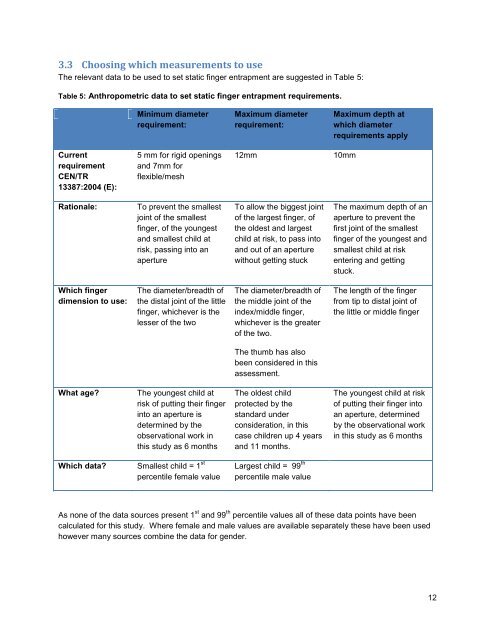Requirements for finger entrapment in European safety ... - ANEC
Requirements for finger entrapment in European safety ... - ANEC
Requirements for finger entrapment in European safety ... - ANEC
Create successful ePaper yourself
Turn your PDF publications into a flip-book with our unique Google optimized e-Paper software.
3.3 Choos<strong>in</strong>g which measurements to use<br />
The relevant data to be used to set static <strong>f<strong>in</strong>ger</strong> <strong>entrapment</strong> are suggested <strong>in</strong> Table 5:<br />
Table 5: Anthropometric data to set static <strong>f<strong>in</strong>ger</strong> <strong>entrapment</strong> requirements.<br />
M<strong>in</strong>imum diameter<br />
requirement:<br />
Maximum diameter<br />
requirement:<br />
Maximum depth at<br />
which diameter<br />
requirements apply<br />
Current<br />
requirement<br />
CEN/TR<br />
13387:2004 (E):<br />
5 mm <strong>for</strong> rigid open<strong>in</strong>gs<br />
and 7mm <strong>for</strong><br />
flexible/mesh<br />
12mm<br />
10mm<br />
Rationale:<br />
To prevent the smallest<br />
jo<strong>in</strong>t of the smallest<br />
<strong>f<strong>in</strong>ger</strong>, of the youngest<br />
and smallest child at<br />
risk, pass<strong>in</strong>g <strong>in</strong>to an<br />
aperture<br />
To allow the biggest jo<strong>in</strong>t<br />
of the largest <strong>f<strong>in</strong>ger</strong>, of<br />
the oldest and largest<br />
child at risk, to pass <strong>in</strong>to<br />
and out of an aperture<br />
without gett<strong>in</strong>g stuck<br />
The maximum depth of an<br />
aperture to prevent the<br />
first jo<strong>in</strong>t of the smallest<br />
<strong>f<strong>in</strong>ger</strong> of the youngest and<br />
smallest child at risk<br />
enter<strong>in</strong>g and gett<strong>in</strong>g<br />
stuck.<br />
Which <strong>f<strong>in</strong>ger</strong><br />
dimension to use:<br />
The diameter/breadth of<br />
the distal jo<strong>in</strong>t of the little<br />
<strong>f<strong>in</strong>ger</strong>, whichever is the<br />
lesser of the two<br />
The diameter/breadth of<br />
the middle jo<strong>in</strong>t of the<br />
<strong>in</strong>dex/middle <strong>f<strong>in</strong>ger</strong>,<br />
whichever is the greater<br />
of the two.<br />
The length of the <strong>f<strong>in</strong>ger</strong><br />
from tip to distal jo<strong>in</strong>t of<br />
the little or middle <strong>f<strong>in</strong>ger</strong><br />
The thumb has also<br />
been considered <strong>in</strong> this<br />
assessment.<br />
What age?<br />
The youngest child at<br />
risk of putt<strong>in</strong>g their <strong>f<strong>in</strong>ger</strong><br />
<strong>in</strong>to an aperture is<br />
determ<strong>in</strong>ed by the<br />
observational work <strong>in</strong><br />
this study as 6 months<br />
The oldest child<br />
protected by the<br />
standard under<br />
consideration, <strong>in</strong> this<br />
case children up 4 years<br />
and 11 months.<br />
The youngest child at risk<br />
of putt<strong>in</strong>g their <strong>f<strong>in</strong>ger</strong> <strong>in</strong>to<br />
an aperture, determ<strong>in</strong>ed<br />
by the observational work<br />
<strong>in</strong> this study as 6 months<br />
Which data?<br />
Smallest child = 1 st<br />
percentile female value<br />
Largest child = 99 th<br />
percentile male value<br />
As none of the data sources present 1 st and 99 th percentile values all of these data po<strong>in</strong>ts have been<br />
calculated <strong>for</strong> this study. Where female and male values are available separately these have been used<br />
however many sources comb<strong>in</strong>e the data <strong>for</strong> gender.<br />
12
















